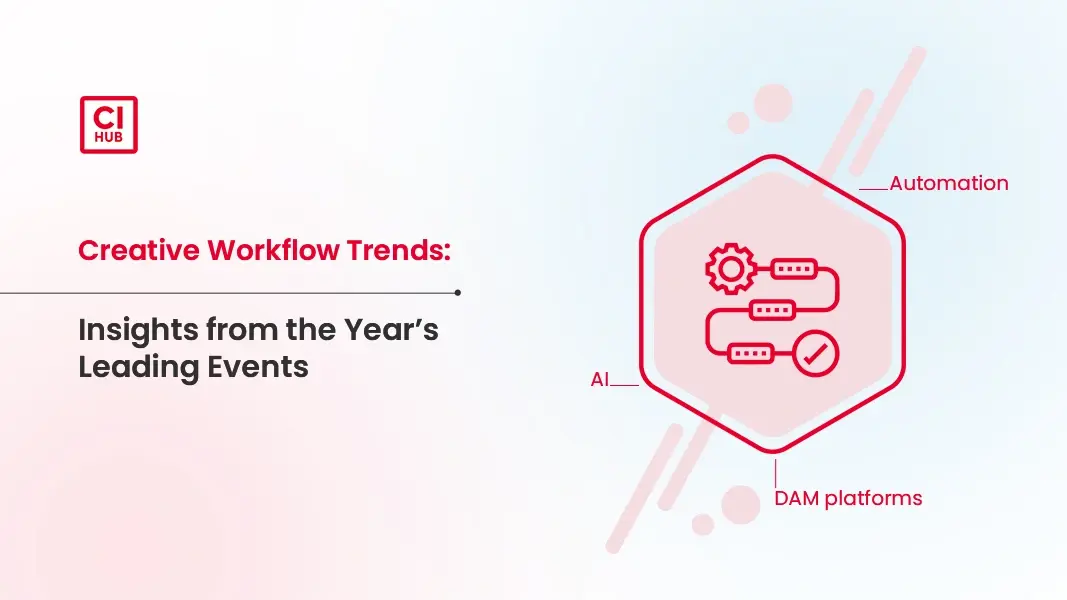
September 26, 2025
Creative Workflow Trends: Insights from the Year’s Leading Events
TL;DR
Creative workflows trends are changing with evolving AI, automation, and DAM platforms. Key trends include AI-assisted asset management, smart automation, and integrated collaboration. Industry events showcase practical demos, best practices, and insights to help teams streamline operations, maintain governance, and scale content efficiently.
In this post, we will explain the following:
Introduction
Key Workflow Trends in Creative Environment
Where These Trends Come to Life: Key 2025 Events
How We Engage In The Conversations
Looking Ahead
Frequently Asked Questions
Introduction
AI-assisted design, integrated DAM platforms, and automated creative workflows are moving the creative industry forward in leaps and bounds. Industry gatherings throughout 2025 have provided a window into these trends, offering practical demos and case studies that show how teams can modernize their operations, improve collaboration, and maintain governance while delivering content at volume. This blog highlights the trends redefining creative operations and the top events where these innovations come to life.
Key Workflow Trends in Creative Environments
Creative teams are exploring new workflows to keep up with faster content demands. Here are the key trends shaping creative operations in 2025:
Generative AI Transforms Image Licensing and Rights Management
According to a study by Adobe, around 83% professionals are using generative AI in their creative work. This rise of generative AI is reshaping how creative teams handle image licensing and rights. Challenges that didn’t exist a couple of years ago now require new policies, tools, and clear governance.
- Licensing models are changing: Stock providers are introducing new frameworks to address how AI training data is used and licensed.
- Brands need clear policies: Without defined rules, AI-generated assets can create uncertainty and potential rights conflicts.
- DAM systems must adapt: Modern platforms now need to track AI-generated content separately from traditional assets.
- Metadata is evolving: Standards are being updated to include details on AI generation, licensing restrictions, and usage rights.
DAM’s Evolution: From File Storage to Creative Operations Hub
Digital asset management has moved far beyond basic file storage. Advanced DAM platforms act as the strategic hub of creative operations, connecting content, people, and processes into a single system of record.
- AI-powered tagging and search: Machine learning analyzes images and video, generating metadata that makes assets easier to find while reducing manual cataloging.
- Seamless integrations: DAM Connectors link digital asset management platforms with Adobe Creative Suite, Microsoft Office, and marketing automation tools, allowing creative work to flow without technical barriers.
- Collaboration at scale: Real-time features like version control and approval workflows help distributed teams stay aligned and projects move faster.
Explore our blog on How AI in Digital Asset Management Simplifies Complex Workflows to see real-world examples of these capabilities.

Scaling Content Operations with Smart Automation
The pressure to deliver content faster is increasing as brands compete across more channels and markets. To keep pace, creative operations teams are turning to structured workflows and business process automation that balance speed with quality.
- Automated templating: Campaign variations can be produced quickly while maintaining brand consistency. Integrated with DAM platforms, templates pull in approved assets automatically, reducing errors and production delays.
- Maintaining brand consistency. Integrated with DAM platforms, templates pull in approved assets automatically, reducing errors and production delays.
- Creative Workflow automation: Routine tasks like resizing, watermarking, and distributing assets across channels can be handled automatically. This shifts creative talent away from repetitive execution and toward strategic work.
- Data-driven optimization: Performance analytics highlight bottlenecks and show which workflows deliver the best results. These insights guide continuous improvement and reveal where additional automation could create efficiency gains.
AI Integration in Enterprise Design Workflows
Enterprise design teams are leveraging AI technologies to speed up production and keep human creativity at the forefront. These systems act as creative partners, making it easier to test ideas, maintain consistency, and scale campaigns globally.
- Faster concepting: Multi-modal AI can create early layouts, color schemes, and design alternatives based on a brief so that teams can try directions rapidly.
- Real-time co-creation: Designers can collaborate with AI, evaluating several possibilities simultaneously and polishing the most promising ideas with human judgment.
- Built-in brand governance: Brand rules learned by machine learning models allow them to mark off-brand designs or propose fixes to maintain creative consistency.
- Regional adaptation: Campaigns can be adapted to regions and languages without sacrificing the underlying message or visual identity.
Brand Collaborations Drive New Licensing Models
Licensing is no longer solely applied to stock photography. Creative teams now oversee brand partnerships that entail co-owned intellectual property and co-branded marketing campaigns. These co-branding arrangements bring additional complexities regarding ownership, rights, and clearances.
- Complicated rights management: Content will often cross multiple forms of ownership, so it is critical that DAM systems are capable of tracking licensing terms and conditions, restrictions, and expiration dates.
- Cross-organization approvals: Joint projects need workflow systems that can manage input from various stakeholders while ensuring processes are secure and efficient.
- Integrated compliance: Automated audits in creative workflows enable teams to ensure proper rights usage and prevent conflicts when assets are transferred between partners.
Where These Trends Come to Life: Key 2025 Events
The creative industry thrives on innovation, and nothing showcases the latest workflow trends like leading industry events. Throughout 2025, conferences around the world are highlighting how AI, automation, and modern DAM platforms are transforming creative operations. From licensing challenges to cross-team collaboration, these gatherings provide insights, hands-on demos, and practical case studies that teams can apply immediately to streamline their workflows. Here’s a snapshot of the key events where these innovations come to life.
| Event | Date & Location | Focus Areas / Key Themes |
|---|---|---|
| BAPLA FOCUS 2025 | Sept. 25, London | - AI-assisted tagging - Secure licensing workflows - Evolving role of images |
| DAM New York 2025 | Oct. 14–15, New York | - Emerging DAM strategies - Impact of integrations on creative speed |
| Smartsheet Engage 2025 | Nov. 5–7, Seattle, WA | - Hands-on labs for real-time integrations - Scaling Smartsheet across departments - Aligning creative & operational teams |
| DAM Sydney 2025 | Nov. 6, Sydney | - Brand governance and taxonomy - Scaling DAM across distributed teams - Global best practices for regional challenges |
| OnDAM Paris 2025 | Nov. 18–19, Paris | - AI and automation in asset management - DAM reshaping creative processes - In-app connectivity for brand consistency |
These events offer a firsthand look at how DAM platforms and generative AI are shaping creative workflows. By exploring the insights, demos, and practical applications shared, teams can adapt their processes and work more efficiently.
Also read: CI HUB Returns to DAM New York 2025!
How We Engage In The Conversations
If you want to see a DAM connector in action, follow our event updates for demo times and workshop sign-ups. We will share short technical sessions that explain how connectors work and how they reduce rework while supporting compliance at scale!
Looking Ahead
Industry events of this year have emphasized how AI and workflow automation are being implemented in real-world scenarios. Teams that pick up on these learnings, experiment with solutions within their own workflows, and adapt based on outcomes will be able to address increasing content demands. Scalable operations, effective collaboration, and governance with continuous creative delivery across channels are at the forefront.
Frequently Asked Questions
The majority of events include demos, workshops, and panels demonstrating AI tools, DAM integrations, and automation of workflow.
Yes, sessions discuss content operations, rights management, and collaboration strategies that are applicable to both marketing and creative professionals.
Most events allow online registration for sessions, workshops, or demos. Early sign-ups often secure access to limited-capacity hands-on labs and technical sessions.

Article by
Michael Wilkinson
Marketing & Communications Consultant of CI HUB